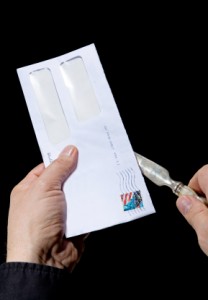Posted by Teresa on July 22, 2011 under Landlord Tips, Rents and Deposits | 
 As a landlord, you must cover your expenses of the maintenance and repairs you perform between tenants. If you or a tenant ends a lease, it is your right to make appropriate deductions from his or her security deposit to cover all damages or extra cleaning required to return your rental property to the condition in which they found it.
As a landlord, you must cover your expenses of the maintenance and repairs you perform between tenants. If you or a tenant ends a lease, it is your right to make appropriate deductions from his or her security deposit to cover all damages or extra cleaning required to return your rental property to the condition in which they found it.
Examples of Damage or Excessive Cleaning Required
• Broken tile in bathroom or kitchen
• Water stains caused by open windows
• Damaged or missing mini blinds or window treatments
• Large holes in walls
• Stopped-up toilet due to debris, diapers, or other items left inside
• Doors pulled off hinges
• Gouges in walls or floors that require filling
• Cigarette burns or stains anywhere
• Stains in carpet
• Excessive dirt, grime and stickiness, on countertops, floors, etc.
However, landlords may not deduct money from a tenant’s security deposit to cover ordinary wear and tear.
Examples of Ordinary Wear and Tear
• Minor wall scuffs
• Small tack or nail holes in the wall
• Faded paint or carpet
• Worn areas in carpet or hardwood or linoleum floors
• Dusty or dirty mini blinds
• Water stains in the bathroom or kitchen caused by faulty faucets or hard water
• Dents in walls caused by doorknobs
• Mild dirt or spots on carpets
To facilitate the return of a tenant’s deposit, set up a move-in checklist and inspection for each tenant, and compare it to a move-out inspection and checklist. Conduct the move-out inspection with your tenant, and indicate which items need to be replaced or repaired. Get the tenant’s signature to prove they were present and agree to the list of damages. And don’t forget that you’ll avoid disagreements over security deposits by being reasonable—cover your expenses, but don’t gouge your tenants.
Protect your rental property and assets through tenant background checks. Proper tenant screening will ensure you are leasing to the best possible tenants.
Posted by Teresa on January 5, 2010 under Landlord and Tenant FAQs, Landlord Tenant Lawsuits | 
 Where are landlords required to place security deposit funds in FDIC-insured institutions? Are you allowed to earn interest on your tenant’s security deposit, or must you turn interest over to the tenant at the end of the lease? How long are you legally allowed to hold the deposit after your tenant moves out?
Where are landlords required to place security deposit funds in FDIC-insured institutions? Are you allowed to earn interest on your tenant’s security deposit, or must you turn interest over to the tenant at the end of the lease? How long are you legally allowed to hold the deposit after your tenant moves out?
Every state has its own laws regarding how landlords handle security deposits. As a rental property owner, you must be familiar with your state and local regulations.
Here are some general guidelines that can help keep you on the up-and-up in most states. Dealing with your tenants as fairly, openly, and honestly as possible is the first step to keeping security deposit headaches to a minimum.
Interest: In many states, landlords with a minimum number of units are required to place security deposits in interest-bearing savings accounts. Some require separate accounts for each tenant; others allow one account, but no comingling of the landlord’s own funds. If you reside in one of these states, you have the choice of paying the interest at the end of the lease, or for long-term tenants, paying the interest once or twice a year. With interest rates currently low, the total interest earned is not much. We know a landlord who gives his tenants their interest checks each year in December—just in time for the holidays.
Rent vs. Deposit: Do not confuse the two, nor allow your tenants to do so. Rent is rent. The security deposit is meant to cover the property owner’s expenses if the tenant fails to keep the property in good working order or to cover tenant damages. If a tenants gives notice and expects you to keep the security deposit as last month’s rent, you may have grounds for eviction. Clearing up the tenant’s misunderstanding is probably a simpler way to go, however. Tip: be sure to include clear language in your lease about the amount of the security deposit, when and under what circumstances the tenant will receive it after the lease ends, and that it may not be used in lieu of rent payment.
Deductions: A move-in inspection and checklist, compared with a move-out inspection and checklist, will likely dispel any conflicts over deductions for cleaning, repairs, and damages. Conduct the move-out inspection with your tenant. Point out items that must be replaced or repaired. Obtain their signature to prove they were present and agree to the list of damages. Then, be reasonable about costs—recover your expenses, but don’t gouge your tenants.
Time Limitations: Landlords must deal with security deposits in a timely manner after the tenant moves out. It’s not fair to drag the process on indefinitely, keeping the tenant’s money tied up. Do the right thing and deal with damages, send an accounting of what was deducted from the deposit, and include a check for the balance to your tenant as soon as possible. Besides, most states require landlords to supply an explanation within a certain number of days.
Second Chance: Times are tough for almost everyone. Why not be an exceptional landlord and help your good tenants keep more of their hard-earned money? After the move-out inspection, set up a second walk-through to give the tenant a chance to right the wrongs you point out. Most tenants are capable of performing minor repairs and giving the unit a good scrubbing. Clearly communicate your expectations and give the tenant a chance to meet them.
We recommend you also automatically screen all tenants as part of your application process. For more landlord resources, including forms and information on tenant screening, turn to E-Renter.com. .
 As a landlord, you must cover your expenses of the maintenance and repairs you perform between tenants. If you or a tenant ends a lease, it is your right to make appropriate deductions from his or her security deposit to cover all damages or extra cleaning required to return your rental property to the condition in which they found it.
As a landlord, you must cover your expenses of the maintenance and repairs you perform between tenants. If you or a tenant ends a lease, it is your right to make appropriate deductions from his or her security deposit to cover all damages or extra cleaning required to return your rental property to the condition in which they found it.
